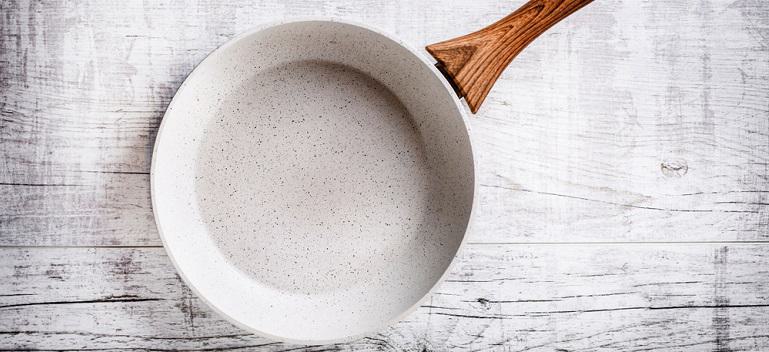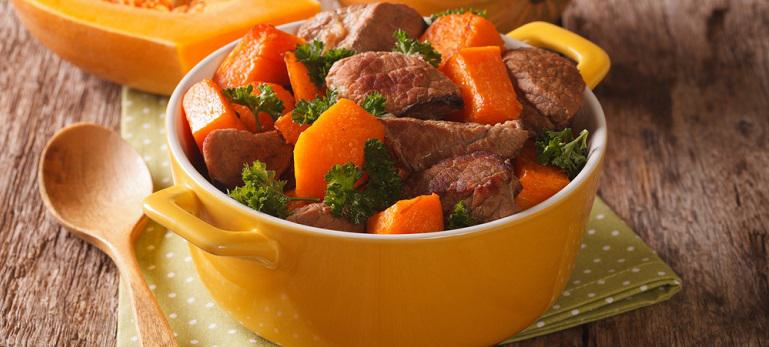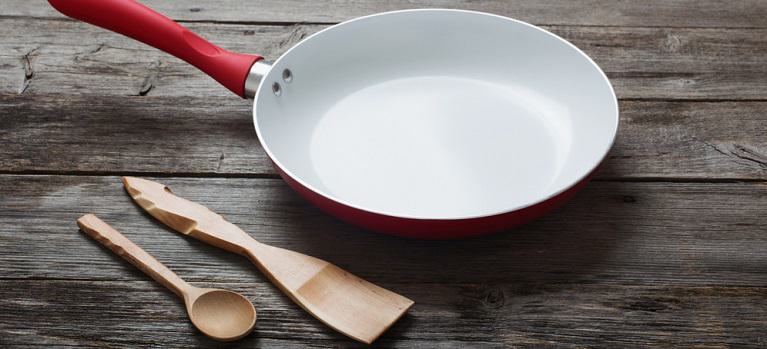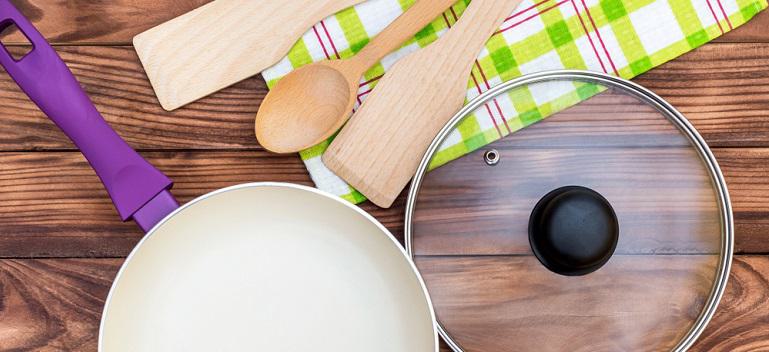If you're in the market for a new nonstick cookware set, then you've likely done quite a bit of research on which type of pots and pans will work best in your kitchen. Choosing cookware that works well with your cooking style and abilities is an essential part of
well-made recipes.
Ceramic pots and pans are among the most popular cookware types and because of their health benefits, many health-conscious cooks are switching over to them. Because ceramic cookware comes with a coating on the surface, it provides a nonstick cooking surface, great for preparing various recipes.
After a while, your ceramic cookware may lose its nonstick properties. If you find this happening, then you may be wondering whether your nonstick pan needs a little TLC or if it's time to upgrade to a new set. In this article, we'll cover the pros and cons of ceramic cookware, their average lifespan and how to care for them properly.
How Long Does Ceramic Cookware Last?
 When compared to other types of traditional nonstick pan and cookware materials like stainless steel cookware or Teflon cookware; ceramic cookware generally has a much shorter lifespan. Average ceramic cookware will last for about a year, whereas quality ceramics can last for up to 3 years when well taken care of.
The main reason ceramic cookware may need to be thrown out is that it loses its nonstick coating. Though ceramic pots and pans are both durable and resistant, they can lose their nonstick coating quickly if not used properly. High temperatures, cooking sprays and rough cleaning can slowly cause the coating to deteriorate.
Though it won't happen immediately, once the nonstick coating does begin to fade, you must care for it properly. Using sharp utensils and stiff cleaning brushes will weaken the layer and result in stains and food sticking to the pans.
If you notice that your ceramic pans have become harder to clean and your efforts of repairing the nonstick coating aren't working, it's likely time to throw out your pans and purchase new ones. Once a ceramic coating has worn down significantly, it may start to crack and chip, mixing in with your food which can quickly prove to be a health hazard.
When compared to other types of traditional nonstick pan and cookware materials like stainless steel cookware or Teflon cookware; ceramic cookware generally has a much shorter lifespan. Average ceramic cookware will last for about a year, whereas quality ceramics can last for up to 3 years when well taken care of.
The main reason ceramic cookware may need to be thrown out is that it loses its nonstick coating. Though ceramic pots and pans are both durable and resistant, they can lose their nonstick coating quickly if not used properly. High temperatures, cooking sprays and rough cleaning can slowly cause the coating to deteriorate.
Though it won't happen immediately, once the nonstick coating does begin to fade, you must care for it properly. Using sharp utensils and stiff cleaning brushes will weaken the layer and result in stains and food sticking to the pans.
If you notice that your ceramic pans have become harder to clean and your efforts of repairing the nonstick coating aren't working, it's likely time to throw out your pans and purchase new ones. Once a ceramic coating has worn down significantly, it may start to crack and chip, mixing in with your food which can quickly prove to be a health hazard.
Benefits of Ceramic Pots and Pans
 Though ceramic pots and pans have a shorter lifespan than other cooking materials, there are still many reasons to purchase a ceramic cookware set. Here are some of the main reasons you should invest in ceramics today.
Though ceramic pots and pans have a shorter lifespan than other cooking materials, there are still many reasons to purchase a ceramic cookware set. Here are some of the main reasons you should invest in ceramics today.
Ceramic Cookware Is a Health-Conscious Option
When purchasing pots and pans, the health advantages of ceramic coated cookware make it an excellent choice. Great for health-conscious cooks, ceramic cookware has a nonstick coating that requires less fat and oil to cook your favorite recipes. In fact, many recipes don't require any oil at all. Not only does this cut down on the number of cooking oils used, but it also helps keep your recipes light and low in calories.
Ceramic Cookware Is Easy to Clean
For many at-home chefs, cooking is a fun experience and a way to get creative in the kitchen. The downside? The number of dirty pots and pans that build up in the sink afterward. If you're tired of seeing the stack of dirty dishware in the sink, it's time to invest in ceramic cookware.
Because food won't stick to ceramic pots and pans, they are much easier to clean, which means you can spend more time cooking and enjoying your food and less time on the cleanup.
Ceramic Pans Are Free of Toxins
One of the safest cooking materials to use is a nonstick skillet, a ceramic coated pan that is free of harmful toxins that many other nonstick pots and pans bear. The nonstick coating used on high-quality ceramic cookware is made of safe materials that won't transfer from the nono your food.
Ceramic Cookware Is Non-Reactive
One of the most notable qualities of ceramic pots and pans is that they are non-reactive. This means that you can quickly cook acidic foods on them without worrying about their nonstick coating being damaged in any way.
Pans that don't have a ceramic coating may react with highly acidic foods, causing the chemicals of the pan to mix with the food, changing its taste and color. The non-reactivity of ceramic cookware makes them a safer and tastier way to enjoy all kinds of recipesincluding the acidic ones.
Ceramic Cookware Is Versatile
Whether your kitchen has a certain aesthetic or you'd like to switch it up and choose a unique color for your new nonstick cookware, ceramic pots and pans come in a variety of styles and colors. Whereas most cookware can be found in grey or black, a ceramic pan can be purchased in colors ranging from orange and blue to neutrals like tan and white.
How to Care for Ceramic Cookware
 Ceramic nonstick pans will last for a long time if cared for properly. Ensure that your ceramic pans remain in top shape by following the tips and tricks below.
Ceramic nonstick pans will last for a long time if cared for properly. Ensure that your ceramic pans remain in top shape by following the tips and tricks below.
Wash Ceramic Pans Before Cooking
When using any new pan, it's essential to wash it before cooking in it. Using simple dish soap, a soft sponge and water should be enough to clean your pan from any dirt, debris, or oil that's stuck to it. Unlike other pan materials, ceramic nonstick cookware doesn't require oil or seasoning before use. All they need is a quick wash to prepare them for cooking.
Use Soft/Safe Utensils on Your Ceramic Pans
Using a sharp metal utensil or those made of too rough materials on your pure ceramic cookware can cause the nonstick ceramic coating on them to wear off quicker than expected. While metal and stainless steel utensils are sturdy, they can easily scratch through your pan's nonstick surface.
Once your ceramic pan becomes scratched, the coating will begin to peel off more and more and you may notice food sticking to the surface. While there are ways to better care for a ceramic nonstick pan that's losing its coating, it's best to prevent the non stick surface from being damaged in the first place. To do so, stick to using soft utensils that won't damage your ceramic cookware. Utensils made out of wood, plastic and silicone are ideal when using ceramic cookware. Using these kitchen tools will extend the lifespan of your ceramic pans.
Use Low Heat
To prevent the coating on your ceramic pans from being damaged, cook your recipes on low or medium heat. Because ceramic pans are an excellent conveyor of heat, food can be thoroughly cooked at low and medium temperatures.
Additionally, cooking at low-temperature levels will not damage your ceramics. Although using your pan with nonstick coating on an induction cooktop is advised, using them on a gas cooktop is also okay.
However, exposing your cookware to high temperatures will deteriorate nonstick coatings and shorten the lifespan of your ceramics.
Avoid Keeping Food in Your Ceramic Pans
While it may be tempting to leave food cleanup for another time, one of the worst things you can do to your ceramic pans is store food in them. Turning your nonstick cookware into a food storage item is never advised. In addition to being harmful to the coating, leaving food in ceramic cookware exposes your recipe to air and fluctuating temperatures, which can breed bacteria over time.
How to Clean Ceramic Non-stick Pans
 Want to extend the life of your ceramic pots and pans? Be sure to clean them properly. While some ceramic cookware may be regarded as dishwasher safe, we recommend washing your pots by hand when possible. Because ceramic pans have a nonstick coating, the high temperatures and steam that dishwashers produce can easily damage them.
To correctly wash your ceramic pots and pans, follow these steps:
Want to extend the life of your ceramic pots and pans? Be sure to clean them properly. While some ceramic cookware may be regarded as dishwasher safe, we recommend washing your pots by hand when possible. Because ceramic pans have a nonstick coating, the high temperatures and steam that dishwashers produce can easily damage them.
To correctly wash your ceramic pots and pans, follow these steps:
Let Your Pots and Pans Cool Off
Before washing your ceramic cookware, be sure to let it cool fully. Letting your pans cool off before running them under cold water will ensure that they don't warp or crack under pressure.
Use a Soft Sponge
To evade scratching your cookware's surface, always use a soft sponge and mild dish soap to wash your ceramic pots and pans. Avoid using abrasive products like steel wool or stiff bristle brushes, as they may damage your nonstick coating.
Remove Burnt-On Food From Ceramic Cookware
Because ceramic cookware is nonstick, you won't have to worry about burnt-on food stains often. If you notice that food has stuck, or burned to the bottom of your pans, remove it by letting your ceramics soak in hot water for half an hour to an hour. After soaking your pans, the food should clear pretty quickly.
Wash the Sides and Bottom of Your Pan
When washing your ceramic cookware, don't neglect the sides and bottom of the pan. While we often remember to clean the inside of the pan, leftover grease and food on its sides can lead to discoloration and eventually affect the nonstick coating.
When purchasing a new set of ceramic cookware, there are several pros and cons to be aware of. Ultimately you'll want to decide what cookware is best for you based on your cooking style and the frequency in which you use your pots and pans. If you're looking for nonstick and health-conscious cookware, ceramic pots and pans will make a great addition to your kitchenand possibly a colorful one too!



 When compared to other types of traditional nonstick pan and cookware materials like stainless steel cookware or Teflon cookware; ceramic cookware generally has a much shorter lifespan. Average ceramic cookware will last for about a year, whereas quality ceramics can last for up to 3 years when well taken care of.
The main reason ceramic cookware may need to be thrown out is that it loses its nonstick coating. Though ceramic pots and pans are both durable and resistant, they can lose their nonstick coating quickly if not used properly. High temperatures, cooking sprays and rough cleaning can slowly cause the coating to deteriorate.
Though it won't happen immediately, once the nonstick coating does begin to fade, you must care for it properly. Using sharp utensils and stiff cleaning brushes will weaken the layer and result in stains and food sticking to the pans.
If you notice that your ceramic pans have become harder to clean and your efforts of repairing the nonstick coating aren't working, it's likely time to throw out your pans and purchase new ones. Once a ceramic coating has worn down significantly, it may start to crack and chip, mixing in with your food which can quickly prove to be a health hazard.
When compared to other types of traditional nonstick pan and cookware materials like stainless steel cookware or Teflon cookware; ceramic cookware generally has a much shorter lifespan. Average ceramic cookware will last for about a year, whereas quality ceramics can last for up to 3 years when well taken care of.
The main reason ceramic cookware may need to be thrown out is that it loses its nonstick coating. Though ceramic pots and pans are both durable and resistant, they can lose their nonstick coating quickly if not used properly. High temperatures, cooking sprays and rough cleaning can slowly cause the coating to deteriorate.
Though it won't happen immediately, once the nonstick coating does begin to fade, you must care for it properly. Using sharp utensils and stiff cleaning brushes will weaken the layer and result in stains and food sticking to the pans.
If you notice that your ceramic pans have become harder to clean and your efforts of repairing the nonstick coating aren't working, it's likely time to throw out your pans and purchase new ones. Once a ceramic coating has worn down significantly, it may start to crack and chip, mixing in with your food which can quickly prove to be a health hazard.
 Though ceramic pots and pans have a shorter lifespan than other cooking materials, there are still many reasons to purchase a ceramic cookware set. Here are some of the main reasons you should invest in ceramics today.
Though ceramic pots and pans have a shorter lifespan than other cooking materials, there are still many reasons to purchase a ceramic cookware set. Here are some of the main reasons you should invest in ceramics today.
 Ceramic nonstick pans will last for a long time if cared for properly. Ensure that your ceramic pans remain in top shape by following the tips and tricks below.
Ceramic nonstick pans will last for a long time if cared for properly. Ensure that your ceramic pans remain in top shape by following the tips and tricks below.
 Want to extend the life of your ceramic pots and pans? Be sure to clean them properly. While some ceramic cookware may be regarded as dishwasher safe, we recommend washing your pots by hand when possible. Because ceramic pans have a nonstick coating, the high temperatures and steam that dishwashers produce can easily damage them.
To correctly wash your ceramic pots and pans, follow these steps:
Want to extend the life of your ceramic pots and pans? Be sure to clean them properly. While some ceramic cookware may be regarded as dishwasher safe, we recommend washing your pots by hand when possible. Because ceramic pans have a nonstick coating, the high temperatures and steam that dishwashers produce can easily damage them.
To correctly wash your ceramic pots and pans, follow these steps: